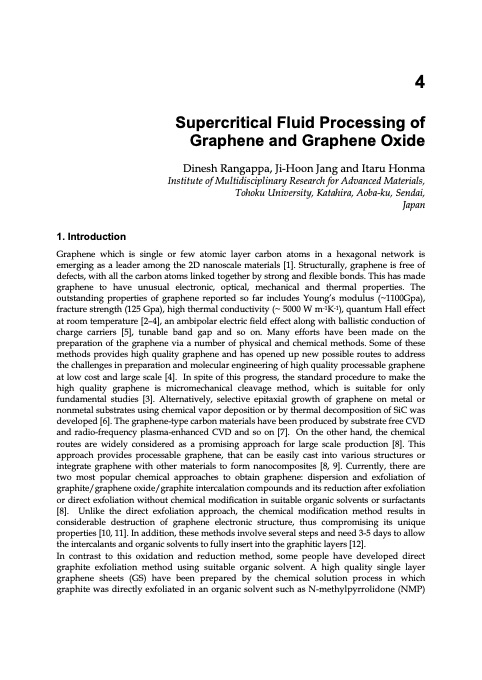
PDF Publication Title:
Text from PDF Page: 055
1. Introduction 4 Supercritical Fluid Processing of Graphene and Graphene Oxide Dinesh Rangappa, Ji-Hoon Jang and Itaru Honma Institute of Multidisciplinary Research for Advanced Materials, Tohoku University, Katahira, Aoba-ku, Sendai, Japan Graphene which is single or few atomic layer carbon atoms in a hexagonal network is emerging as a leader among the 2D nanoscale materials [1]. Structurally, graphene is free of defects, with all the carbon atoms linked together by strong and flexible bonds. This has made graphene to have unusual electronic, optical, mechanical and thermal properties. The outstanding properties of graphene reported so far includes Young’s modulus (~1100Gpa), fracture strength (125 Gpa), high thermal conductivity (~ 5000 W m-1K-1), quantum Hall effect at room temperature [2–4], an ambipolar electric field effect along with ballistic conduction of charge carriers [5], tunable band gap and so on. Many efforts have been made on the preparation of the graphene via a number of physical and chemical methods. Some of these methods provides high quality graphene and has opened up new possible routes to address the challenges in preparation and molecular engineering of high quality processable graphene at low cost and large scale [4]. In spite of this progress, the standard procedure to make the high quality graphene is micromechanical cleavage method, which is suitable for only fundamental studies [3]. Alternatively, selective epitaxial growth of graphene on metal or nonmetal substrates using chemical vapor deposition or by thermal decomposition of SiC was developed [6]. The graphene-type carbon materials have been produced by substrate free CVD and radio-frequency plasma-enhanced CVD and so on [7]. On the other hand, the chemical routes are widely considered as a promising approach for large scale production [8]. This approach provides processable graphene, that can be easily cast into various structures or integrate graphene with other materials to form nanocomposites [8, 9]. Currently, there are two most popular chemical approaches to obtain graphene: dispersion and exfoliation of graphite/graphene oxide/graphite intercalation compounds and its reduction after exfoliation or direct exfoliation without chemical modification in suitable organic solvents or surfactants [8]. Unlike the direct exfoliation approach, the chemical modification method results in considerable destruction of graphene electronic structure, thus compromising its unique properties [10, 11]. In addition, these methods involve several steps and need 3-5 days to allow the intercalants and organic solvents to fully insert into the graphitic layers [12]. In contrast to this oxidation and reduction method, some people have developed direct graphite exfoliation method using suitable organic solvent. A high quality single layer graphene sheets (GS) have been prepared by the chemical solution process in which graphite was directly exfoliated in an organic solvent such as N-methylpyrrolidone (NMP)PDF Image | GRAPHENE SYNTHESIS CHARACTERIZATION PROPERTIES

PDF Search Title:
GRAPHENE SYNTHESIS CHARACTERIZATION PROPERTIESOriginal File Name Searched:
Graphene-Synthesis.pdfDIY PDF Search: Google It | Yahoo | Bing
Salgenx Redox Flow Battery Technology: Power up your energy storage game with Salgenx Salt Water Battery. With its advanced technology, the flow battery provides reliable, scalable, and sustainable energy storage for utility-scale projects. Upgrade to a Salgenx flow battery today and take control of your energy future.
| CONTACT TEL: 608-238-6001 Email: greg@infinityturbine.com | RSS | AMP |